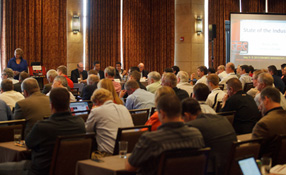 |
| SWIFT is a wireless fire detector line offered by Honeywell Fire Systems |
Honeywell Fire Systems, Northford, Conn., continues to enhance its line of wireless fire detectors, announcing new updates to its Fire-Lite® Alarms Smart Wireless Integrated Fire Technology (SWIFT™) at ISC West 2015 in Las Vegas.
The SWIFT line of wireless fire alarm detectors and modules – which includes smoke, heat and pull stations – integrate with new and existing Fire-Lite Alarms systems to provide smarter, cost-conscious solutions for myriad applications. Now, after stringent evaluation and testing, SWIFT has earned approvals from the Fire Department of New York (FDNY) and California State Fire Marshal (CSFM). In addition, SWIFT detectors are also now Underwriters Laboratories listed for an extended two-year battery life.
“Dealers are increasingly interested in wireless fire alarm detection and have been attending training classes specifically to learn more about how they and their customers can benefit, because it extends the number of applications in which they can more cost effectively and efficiently deploy the technology,” said Beth Welch, manager of Public Relations for Honeywell Fire Systems.
“SWIFT allows integrators to use the devices in temporary facilities and buildings where they can deploy it quickly while still meeting building and fire codes,” she adds. For new applications and existing system expansions, SWIFT handles challenging wire installations, and high-value or historically-significant facilities. But in addition, Welch cited these new and emerging installation opportunities for SWIFT, including:
 |
| SWIFT wireless fire alarm detectors and modules provide smarter, cost-conscious solutions for myriad applications |
- Temporary facilities found on many military bases and construction sites, in addition to make-shift classrooms, offices and event venues;
- Building areas under construction or containing a system in disrepair, and needing temporary protection to avoid costly fire watch expenses;
- Barns where the installation and site of wire can negatively affect animals, or inversely where environmental issues can potentially erode wire;
- Building tenant areas where wall and ceiling locations are frequently changed, causing fire alarm field devices to be repeatedly moved and re-wired;
- Requests by building owners for a wireless system.
At the show, Honeywell announced the updates to the line, which includes longer battery life, agency listings, accredited technical training and an enhanced software suite of new utilities. The expanded array of dealer support offerings not only has enabled installers to obtain new opportunities using wireless technology, but allowed them to expand into emerging markets, such as those cited above. In addition, because of the robustness of the technology and its use of mesh networking, wireless is increasingly accepted across the country by the Authority Having Jurisdiction (AHJ), Welch added.
Other major updates have been made to the SWIFT Tools software utility used by dealers to evaluate sites for installations, to configure wireless mesh networks and to extract valuable diagnostic information. The latest version 1.5 offers a more enhanced user experience when performing site surveys site and mesh network configurations, plus more detailed diagnostics on individual device signal strengths. Real-time data and more intelligent displays are designed to make it easier to set up and reconfigure SWIFT systems. All this is helping systems integrators become more confident and efficient in installing wireless fire technology.
“We’ve witnessed a number of SWIFT site surveys and installs, and there are a growing number of instances where wireless detectors are the most simple and beneficial solution,” said David Pakech, vice president of Sales, Fire-Lite Alarms. “Whether wiring a certain area is difficult, or you’ve got a tight timeline, or it’s just an easier option for traditional jobs, dealers are really gravitating toward the SWIFT line.”














































